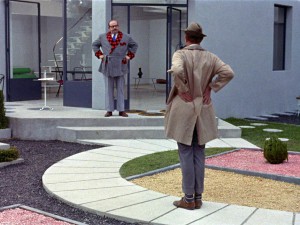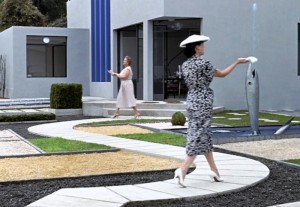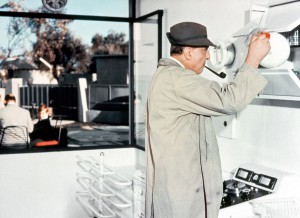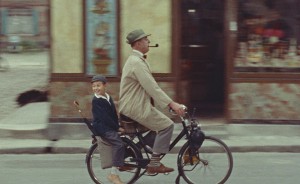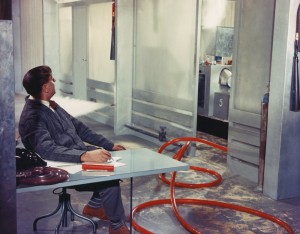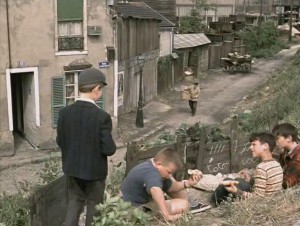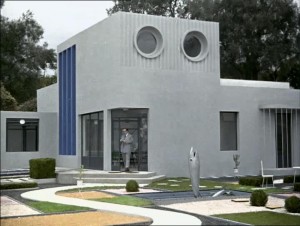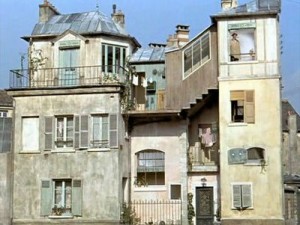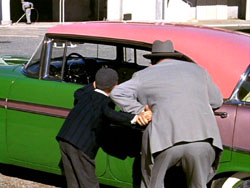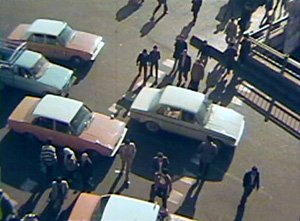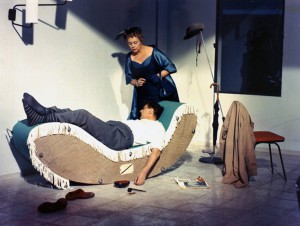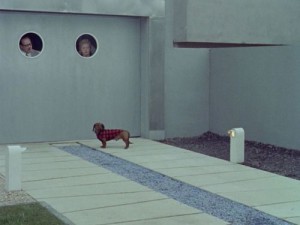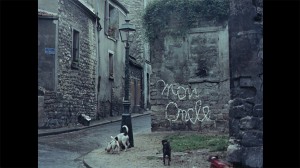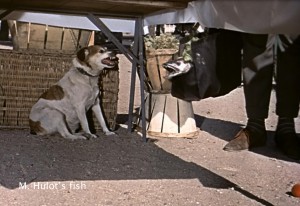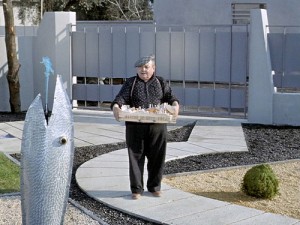Written in 2013 for a 2019 Taschen publication. — J.R.
Mon Oncle
1. Preparations and Preludes
A lot of thoughts and deliberations preceded each of Tati’s half-dozen features, which is one of the reasons why a fairly long stretch of time would elapse between any two of them. The longest of these stretches occurred between the release of Les Vacances de M. Hulot in March 1953 and the first day of shooting on Mon Oncle in July 1956, but his thoughts and deliberations about his next feature occupied only part of his time. During those same three years, Tati also had a good many personal matters to attend to. There was his newfound celebrity, which led to a great deal of foreign travel, many offers of various kinds, and several contacts with young people who wanted to work for him: among those he hired during this period were the future writer-director-star Pierre Etaix, who joined his staff and eventually became one of the two assistant directors on Mon Oncle (and also played a cameo in which he imitates the sound of a chicken); the future screenwriter Jean-Claude Carrière, whose first serious job was writing the commissioned novelization of Les Vacances (and who would later write a novelization of Mon Oncle for Tati as well); and a young writer whose first novel impressed Tati, Jean L’Hôte, whom Tati engaged to collaborate with him and Jean Lagrange on the screenplay for Mon Oncle.
During the same period, Tati had complex financial and legal disputes with Fred Orain, the producer of his first two pictures; a very serious car accident in May 1955, when a large car slammed into Tati’s smaller one on the driver’s side while Tati was at the wheel, which led to a lengthy period of recovery; the accidental loss of the safety copies and unedited footage of Les Vacances de M. Hulot due to a misunderstanding with a film laboratory; and family issues that included concerns about the proper school for his son Pierre as well as the retirement of his father, Georges-Emmanuel Tatischeff, from his celebrated picture-framing business, which led to Tati having to sell off his stock of over 700 frames to various galleries around the world. (His father would die around the time he was putting final touches on Mon Oncle.)
Given all the above, it isn’t surprising that the principal film project Tati was contemplating at the time — along with certain other possibilities that fell by the wayside — had something to do with family relationships and generational differences, especially those between children and father figures, as well as pronounced physical changes in France that he saw taking place around him in terms of architecture, design, and various modern gadgets — and, in particular, the cataclysmic transformations brought to French life by the rapid growth of the automobile industry, which included suburbs and all that came with them. More generally, the onset of modernity itself — already an issue regarding the delivery of the mail in Jour de fête, and epitomized here by the noisy demolitions and constructions of buildings that frame Mon Oncle like bookends — would become a major issue and preoccupation over Tati’s next three features.
2. Plot and Characters
At the center of Mon Oncle is the issue of a ten-year-old boy, Gérard Arpel, choosing between father figures, and initially opting for his unemployable uncle (Hulot) over his hyper-successful dad, the executive Charles Arpel, who runs a plastics factory.
The Arpels live with Gérard in a new and self-consciously modern suburban house outfitted with a slew of high-tech mechanical gadgets, including a fully automated kitchen, an equally automated vacuum cleaner, an electric-eye garage door (which comically malfunctions thanks to the family dog), and a mechanical outdoor fountain in the rock-laden front garden, in the shape of a large fish spouting water from its mouth. The parents are delighted with their possessions, which they like to show off to their friends and neighbors, but Gérard, bored and alienated, seems happier spending time with his mother’s brother, the unemployed M. Hulot, whom he usually sees once a week and who lives in an older quarter that’s more relaxed and leisurely even when its everyday operations are less efficient. (For instance, Hulot occupies the top floor of an old building where, from the outside, we see all the complicated passageways and stairways he has to traverse whenever he goes in or out; there’s also an outdoor market in the square, presided over by a city sweeper who’s always looking for excuses not to work, and a neighborhood café, Chez Margot, where Hulot often hangs out.)
Gérard’s preference for his uncle gradually leads to some jealousy and resentment on the father’s part, although, at the urging of his wife, Charles Arpel also tries to find his brother-in-law some work by arranging for a job interview at another industrial plant. But this meeting proves disastrous after Hulot tracks limestone footprints into the personnel manager’s office, whose deceptive pathways lead the manager to assume that he’s been spying on the ladies’ room through an upper window. And after Hulot picks up Gérard from school one day, his nephew joins some of the scrappy local kids as they pull pranks in a vacant lot and then comes home dirty, leading to consternation from his mother, who’s obsessed with cleanliness.
Mme Arpel also thinks her brother should find a wife, and arranges a party in her garden in order to introduce him to a single lady who lives next door, but this plan also misfires after the fountain’s underground plumbing starts to leak and the eligible neighbor is unexpectedly joined by a male friend. Then Arpel hires Hulot to work at his own factory, but Hulot promptly goes to sleep at his station; a machine that produces red tubing then goes haywire and emits tubes that resemble sausages. That night, Hulot and Gérard try to dispose of this embarrassing material while his parents go to a nightclub to celebrate their wedding anniversary. Returning home, they find their living room in disarray and Hulot asleep on the sofa (which he has tuned on its side). For the father, this is the last straw, and he contrives to pack his brother-in-law off to the provinces as a traveling salesman. But after whistling in an effort to catch the attention of Hulot while he’s departing at the airport, he causes someone else to collide distractedly into a lamppost — virtually replicating a prank that Gerard and his working-class pals pulled repeatedly in the terrain vague — and discovers that he can win his son’s affection by showing that he can laugh at an accidental prank of his own.

3. Designing Mon Oncle
According to David Bellos, the architectural style of the Arpel house and garden, which was designed by Jean Lagrange, was intended “as a pastiche of the International Style, which really dates from the years after the First, not the Second World War,” exemplified by both the Art Deco style of Robert Mallet-Stevens and Le Corbusier’s Maison Jeanneret[1], when, as Lagrange himself put it, “young artists who wanted to be avant-garde… fell into the same mistakes as their grandfathers.” Tati’s screenplay describes it more simply as “une villa au modernisme prétentieux, si géométrique qu’elle en a perdu tout caractère habitable et humain. Le jardin est dessiné suivant la même rigueur géométrique. On a forcé les plantes à prendre des formes artificielles.” And Mme. Arpel’s own comment in the film while proudly giving a house tour, “Tout communique,” satirically encapsulates the same point: that the rooms communicate perfectly with one another, unlike the people trapped inside them.
Lagrange’s design for the house was a deliberate stylistic jumble. He said, “I made a collage of illustrations from architectural reviews, with scissors and paste. I took bits from here and bits from there — porthole windows, silly pergolas, winding garden paths to make the plot seem larger.… It’s an architectural potpourri.”[2] From a contemporary standpoint, much of the uncomfortable furniture suggests at times a kind of nightmare dreamt after a visit to Ikea, combined with an antiseptic, sterile ambiance where Madame Arpel’s obsession with cleanliness seems like a logical consequence.
Interviewed by Cahiers du Cinéma a decade after the release of Mon Oncle,[3] Tati expressed some misgivings about having made the Arpel home too ugly and “disagreeable” — not because such monstrosities didn’t exist (in fact, one overzealous fan of the film and the house reportedly had an identical home built in the suburb of Massy-Palaiseau), but because this wasn’t a good enough reason to feature one in his film. (He blamed part of the exaggerated tackiness on his anxiety at the time about using color — and, indeed, the hideous three-toned car that Charles Arpel buys to celebrate his wedding anniversary, mixing pink, green, and lavender, may be even worse than anything in the house and garden.) But he also insisted that it would be wrong to say that he was taking a position against modern architecture per se.[4] “Dans Mon Oncle, j’ai défendu quelque chose,” he said in an interview. “Ne croyez pas que je suis contre les baies vitrées qui donnent sur la verdure. Oh non! Mais je me suis aperçu que dans tout ce que l’on construisait, on enlevait beaucoup de la gentillesse et de l’esprit des choses…. Ce qui me gêne ce n’est pas que l’on construise des immeubles neufs. Il en faut des immeubles. Ce qui me gêne c’est que l’on construise des ‘casernes.’ … Je ne crois pas que les lignes géométriques rendent les gens aimables.” As the description in the screenplay implies, it is the pretentiousness and the implied sense of social superiority projected by such a dwelling and its up-to-date gadgets that he found objectionable.
Because Mon Oncle is more explicitly a satire than any of Tati’s other films, one could argue that is correspondingly somewhat less poetic and more prosaic.[5] But one kind of poetic vision that is threaded beautifully through the entire film might be described as the poetry of disorder, and this is represented above all by the roaming paths of dogs in both neighborhoods, which are explicitly contrasted with the strict, orderly procession of cars on the highway.
One of the early educational shorts of the great Iranian filmmaker Abbas Kiarostami, whose taste for witty long shots often recalls that of Tati, is called Orderly and Disorderly (1981), and it compares these two forms of behavior among schoolchildren as well as with regulated and unregulated city traffic (and complicates the comic differences between them by also recording the voices of Kiarostami and his own film crew during the separate takes, critiquing the organization or disorganization of the camera angles recording these activities). And an essential part of Tati’s design and vision in Mon Oncle relates to the more disorderly aspects of Hulot’s neighborhood and the compulsive orderliness of the Arpel villa, echoed in many ways by the separate movements, regulated and unregulated, of dogs and cars in both neighborhoods. (see Tati and Dogs, below).
Furthermore, part of the satirical point — and therefore part of the overall design — was to project two contrasting life styles and social/cultural milieu, juxtaposing the Arpels’ self-conscious, nouveau riche airs with the old-fashioned quarter where Hulot lives, less “convenient” or efficient in its overall working-class sprawl but far more social and amiable. One also might contend that the difference in class and class attitudes was a crucial part of this contrast. Perhaps the most objectionable side of Mme Arpel’s behavior is the way that she turns on the ridiculous fish-fountain in her garden whenever she hears the door buzzer rung on the front gate, but immediately turns it off as soon as she discovers it’s a fruit and vegetable seller delivering goods for her reception — or, even worse, when she automatically blames her maid, Georgette, on separate occasions both for causing the leak in the fish fountain’s water pipes (actually a leak caused by Hulot) and for accidentally closing her new electric-eye garage door (when in fact it was the family dachshund, Daki).
Hulot, of course, who is neither nouveau riche nor working-class but quintessentially middle-class, even though he feels far more comfortable in the working-class neighborhood, becomes a perfect emissary for the audience between these profoundly separate worlds, and so, in a different way, does Gérard, who is plainly bored by his parents’ house and gadgets and alienated by their social pretensions, clearly preferring the scrappy mischief of his pals from the other neighborhood. And it’s important to stress that, as in almost all of his other films, it is the social realms of both worlds that Tati is concerned with, not their more private and intimate regions; bedrooms and bathrooms are almost entirely absent from what we see in the Arpel house (apart from Gérard’s room, glimpsed only briefly), while the inside of Hulot’s apartment is never seen at all.
Another part of the design can be seen (or, rather, heard) in the deliberate artificiality of much of the soundtrack, which is even more pronounced than the sound design of Les Vacances de M. Hulot — especially when it comes to the more grating sounds of gadgets, appliances, and machines associated with the Arpel residence and the factory, such as the loud buzzes, gurgles, hums, but also in the everyday chatter overheard in Hulot’s neighborhood, or the warble and twitter of the bird in a cage just outside his flat. (Hulot, as in practically all of Les Vacances de M. Hulot, is rarely heard speaking, although he does ask his brother-in-law, “Everything okay?” when he comes over to his house for dinner; but when he whispers what is apparently some off-color joke to a guest at his sister’s reception, provoking her raucous laughter, we can’t hear a word of it.) The kinds of music associated with each of the separate worlds (as well as the streets and highways connecting them) is also a matter of contrast: something close to bouncy Muzak around the Arpel house and factory, jazz (including some Dixieland) when it comes to the traffic scenes, and traditional, folksy French tunes with accordions in Hulot’s neighborhood — the latter showing affection for an older form of everyday French life that Tati feared might be on the verge of disappearing. A similar anxiety is already apparent in the village postman’s worries in Jour de fête, tied to the postwar “invasion” of Americans, and the signs of American influence are not exactly absent from the Arpels’ neighborhood: one of the guests at the garden reception, dressed in a white pants suit, bears a clear resemblance to Marilyn Monroe.
4. Casting and Shooting, Dubbing and Editing
Selecting his cast, Tati was every bit as meticulous and as exhaustive as he tended to be about every other stage of filmmaking. According to biographer Jean-Philippe Guerand, he auditioned something like 600 people for various roles, including sixty alone for Charles Arpel — although he wound up settling on Jean-Pierre Zola, who had already played a distracted businessman for him in Les Vacances de M. Hulot. For Arpel’s fussy wife and Hulot’s sister, he tried out about fifty actresses before selecting Adrienne Servantie, who’d had some limited experience in theater, but hadn’t appeared in a film before (and would subsequently play a few more roles in French features). Ten-year-old Alain Bécourt, who later became known as a performer on French television, played their son and Hulot’s nephew, Gérard; and the daughter of the concierge, Betty Schneider, would go on to play the lead role in Jacques Rivette’s first feature, Paris Belongs To Us, a few years later.
Roughly half of Mon Oncle was shot in the Paris suburbs over about three months: most of the terrain vague was found in Nanterre, Gérard’s school and the Plastac factory where Charles Arpel (and, more briefly, Hulot) works in Créteil; the building and neighborhood where Hulot lives were both located in Saint-Maur; and the airport in the penultimate sequence was Orly (anticipating the opening sequence of PlayTime in a few other particulars as well, such as the arrival of a busload of tourists). But for all the scenes at the Arpel residence, Tati had to move with his family and his actors and crew to Nice, where he rented space at the Victorine Studio for another three months. This was his first extensive experience of working in completely constructed sets, which would comprise almost all of the shooting on his next feature, PlayTime. Most of the production went from the fall of 1956 until late February 1957, and it was filled with many technical problems, some of them relating to Tati’s use of Eastman Color. The grotesquely large fish fountain in the Arpel rock garden, for example, spouted water that was so transparent that it had to be tinted dark blue to make it visible; furthermore, the pipes and pumps that made it spout were subject to leaks — almost duplicating a whole string of gags occurring at the Arpels’ Sunday reception — and at one point the reservoir tank burst. [6]
Editing and sound work took virtually another year; as Tati liked to put it, assembling the soundtrack was like shooting the whole film a second time (and a third time if one included the two separate language versions, detailed below), and this was made no less difficult by Tati’s exacting standards for the use of sound effects. According to his editor Suzanne Baron, he had previously collected sound recordings of no less than 365 different kinds of ocean waves for Les Vacances de M. Hulot, and for Mon Oncle he had eight reels of sound for the fish fountain alone. As she further reported, “Nous avons enregistré le bruit des pas du couple Arpel. Lui, faisant M. Arpel: il avait fixé le fer d’une chaussure au bout d’un crayon. Moi, Mme Arpel à l’aide de deux balles de ping-pong, l’une troués, l’autre pas. Quand on marche, one ne fait pas le même bruit avec le pied droit et avec le pied gauche.”[7]
5. Mon Oncle and My Uncle: Issues of Language and Nationality
Most of Tati’s features have more than one “authorized” version — partly because Tati prepared separate editions of some of them in different languages, and partially because of his penchant for tinkering with and periodically upgrading some of his films in other ways. And part of the pleasure to be found in comparing Mon Oncle (the French version) with My Uncle (the English-language version, seven minutes shorter, later retitled My Uncle Mr. Hulot for its American release) is that, as with the two main versions of Jour de fête and the two main versions of Les Vacances de M. Hulot, they’re really separate films — in this case ones employing at certain junctures different takes and different details as well as separate soundtracks. Some of these differences are already apparent during the credit sequences of each film.
My Uncle was motivated by a desire to simplify and/or clarify a few details in Mon Oncle for American and other English-speaking viewers, and Tati shot it at the same time that he shot the French version, changing even signs so that “École” becomes “School” and “sortie” becomes “exit.” Les Vacances de M. Hulot had already been nominated for an Oscar (for best original screenplay), which may have partially inspired him to tailor a separate version of this film for the U.S.; if so, he succeeded, because My Uncle wound up winning an Academy Award for best foreign picture. Yet paradoxically, some of the English names (ten-year-old Gérard Arpel is now “Jimmy” Arpel) and lines of English dialogue tend to make the characters seem even more French than they do in Mon Oncle — largely because of the selective way English is used, which re-enforces certain classic French stereotypes, especially ones tied to social class. “Jimmy” and his parents speak some English but his scrappier pals and the others in the old quarter speak only French, which leads us to associate speaking English with a certain snobbisme, an upper-class affectation. (In PlayTime, the mix of languages heard, which also includes German, is much more believable.)
Technically, Tati’s first four features are French and his last two are international coproductions, but one could argue that existentially, Jour de fête and Mon Oncle are more French than Les Vacances de M. Hulot and PlayTime, whose characters are conceived in more international terms. (Admittedly, Americans are prominent in portions of Jour de fête, but they figure there as outsiders and as challenges to French traditional life, not as members of the community.) Tati’s sentimental nostalgia for old-fashioned French life that he associates both with chummy get-togethers in cafés, bars, and restaurants and with music becomes evident in all four pictures. One can even find an echo of this attitude in the compulsively sociable street sweeper in Saint-Maur (played by André Dino, who also served as set photographer), breaking away from his job whenever possible to chat with others.
6. Tati and Dogs
Anyone who spent much time with Tati can tell you that he had a special feeling for dogs. He owned several of them over the course of his life, and reportedly he gave the same name to most or all of them, Azor. During the week or so when I was working for him as a script consultant, we would have lunch every day in a bistro downstairs from his office, and on one of those days, while we were finishing up our coffees, I recall him performing for a dog for a good ten minutes or so, plainly more concerned with the dog’s responses to his gestures than with those of any human onlookers.
In fact, my favorite episode in James Harding’s 1984 biography[8] describes Tati’s protracted efforts, adding up to several days of research, to understand the behavior of dogs for the opening of Mon Oncle, which he undertook with his young writing assistant Jean L’Hôte. This was “research” that basically consisted of discreetly following and observing dogs around Tati’s own neighborhood near Place Saint Philippe du Roule to see where they went and observe how they behaved, singly and in clusters. Among other things, he discovered that “the dogs had an intimate knowledge of the basements which honeycombed beneath the square and were able to flit from one to the other with perfect confidence.”
Even though Tati often shows us dogs in Mon Oncle moving in packs (using abandoned canines recruited from a pound — all of whom he found homes for after the shoot, by placing ads in Le Figaro), he also takes special care to treat them as individuals with their own particular looks, breeds, and personalities. Daki, the dachshund belonging to the Arpels, even serves as a doppelganger on various occasions for Gérard (or, by extension, his uncle). Dressed in a Scotch plaid body vest to show that he’s a high-class dog — a precise counterpart to the way Gérard is often treated by his parents — he almost manages to lose this fancy armor early on while wiggling his way through the gate opening of the Arpel estate. Strictly in formal terms, Daki is also “duplicated” in the improbable sausage-shapes that the factory starts churning out instead of plain red hose tubing when, thanks to Hulot’s oversights, the machine starts going haywire. And in an earlier scene at the factory, when we see several dogs follow Hulot into the premises — to be promptly ejected by an irritated guard — the association of these animals with the disruptive hero is spelled out even more explicitly.
7. The reception and legacy of Mon Oncle
Mon Oncle had a huge commercial success — having cost 250,000 francs and made 600,000 — and garnered its share of honors as well, winning the jury prize at the Cannes film festival before receiving its Oscar. When Tati traveled to California to accept his gold statuette, he asked if he could meet one of his favorite silent slapstick role models, Mack Sennett, who was living then at a retirement home. Sennett, who felt honored and flattered by Tati’s interest (although he reportedly remarked that he thought the French comic communicated better when he didn’t have to talk), invited Harold Lloyd, Stan Laurel, and Tati’s particular favorite, Buster Keaton, to join them at an afternoon tea party.
For Tati, such a meeting must have felt like an apotheosis. But meanwhile, not all of the critics in France were as sympathetic as they had been about his first two features. Two of his most unqualified supporters — François Truffaut and his mentor, the great André Bazin — interviewed him at great length in Cahiers du Cinéma (no. 83, mai 1958). Yet when Truffaut came to review Mon Oncle, his support for Tati’s genius this time proved to be highly qualified. Insisting that “Mon Oncle can only be judged in terms of Tati’s other films,” he went on to argue that the film sets were in opposition to “the world of twenty years ago and the world twenty years from now,” and declared that “the whole Saint-Maur part, the life of the little people on the street, the market, the children, is completely charming, pretty, pleasant to watch, truly successful. [But] the modern part, the Arpel family’s house, the factory, is sometimes annoyingly over-insistent…The ultra-modern kitchen is funny the first time, somewhat less so the second, not at all the third.” Finding Tati’s humor “extremely restricted” by being based only on observation and then rejecting everything within that framework that is “not believable,” as well as “editing in the classic sense, the dramatic construction of scenes, and the psychology of characters,” he concluded that “his aesthetic position and insane logic lead to a totally deformed and obsessive world view.”[1] [9]
In striking contrast to Truffaut’s negativity was the far more positive position on Tati’s originality taken by André Bazin: “Il s’agit d’un film qui a sûrement moins de points communs que n’importe quelle autre oeuvre sur pellicule, qu’un opéra chinois avec un vaudeville français. Mon Oncle est une oeuvre aussi individualiste et autonome qu’un roman, un poème ou un tableau.”[10]
A decade later, Truffaut would of course prove to be one of the most passionate defenders of PlayTime. And back in 1958, while a few others of Tati’s fans were somewhat disappointed, a good many others around the world were discovering and celebrating his art for the first time, and more than a little staggered by what they saw.[11] In short, one might even say that thanks to Tati’s most eccentric film, he enjoyed his most impressive mainstream success.
[1] David Bellos, Jacques Tati, London: The Harvill Press, 1999, p. 207.
[2] Ibid.
[3] Cahiers du Cinéma number 199, March 1968, p. 15
[4] “Unifrance Film, March-April-May 1958.
[5] Tati expressed some dissatisfaction with the film in later years because of its relative conventionality, as comedy as well as narrative, maintaining that because Mon Oncle was more of a comedy in the traditional sense than Les Vacances de M. Hulot, it tended to age less well. This may seem like an ironic and contrary position for Tati to have taken towards his most famous and, for some, his most beloved feature, but it isn’t inconsistent with the high critical standards he set for himself, which didn’t equate artistic success with commercial success in the manner of certain Hollywood directors.
[6] More generally, Tati’s first film to be released in color differs noticeably in its employments of color from both Jour de fête (shot simultaneously in black and white and color, but due to technical complications, not processed in color until more than a decade after his death) and PlayTime, where in both cases it is far more subdued and used for subtle accents. The latter film was designed to start off in greyish monotone and then gradually acquire colors when the story and characters became more festive. In Mon Oncle, by contrast, the brightness and loudness of the red plastic tubing at the Arpel factory is even part of the satiric point, as are the pink, green, and lavender of Arpel’s shiny new car.
[7] Marc Dondey, Tati, Paris: Ramsay, 1993, p. 145.
[8] James Harding, Jacques Tati: Frame by Frame, London: Secker & Warburg.
[9] François Truffaut, The Films in My Life, translated by Leonard Mayhew, New York: Simon and Schuster, 1975, pp. 235-237.
[10] France-Observateur, 15 mai 1958.
[11] I was one of those latter people, having seen Mon Oncle for the first time in my home town of Florence, Alabama. To the best of my knowledge, it has been the only one of Tati’s features ever to have had a commercial run there, and Marie-France Siegler — who likewise grew up in Alabama and who would become Tati’s main assistant a few years later — also discovered Tati’s art via Mon Oncle, in her case in Birmingham.

